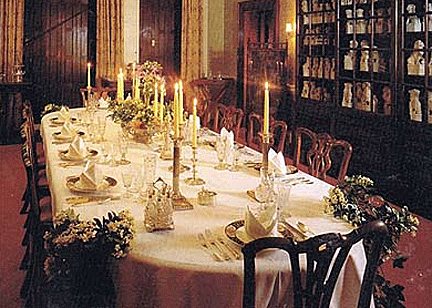 Dining
in the homes of wealthy Victorians was an experience. Not only did the
etiquette of the day dictate who sat where, decorum at the dinner table,
and conversational protocol, it also dictated what dish was to be used
with which food and which utensil should be used to eat it.
Dining
in the homes of wealthy Victorians was an experience. Not only did the
etiquette of the day dictate who sat where, decorum at the dinner table,
and conversational protocol, it also dictated what dish was to be used
with which food and which utensil should be used to eat it.
Not only were the dinner hosts and their guests
dressed formally for dinner, so was the dinner table, itself. Because
formal Victorian dinners were so complex, dining rooms featured massive
dining tables, sideboards and buffets. At the heart of the dinner was
the properly set Victorian table, with individual place settings
containing up to 24 pieces of silver to accommodate elaborate menus
often consisting of up to 12 courses.
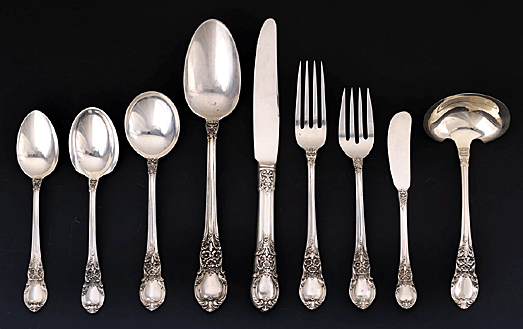
As many as eight forks could occupy one place setting, with an equal
number of knives and an assortment of spoons to cover a myriad of food
and drink items that included cream soups, clear soups, hot or iced tea,
coffee and dessert. In addition to the flatware, tables were filled with
silver serving dishes, condiment dishes, cake stands, fruit stands,
cruets, asparagus tongs, game sheers and picks for butter or nuts.
Victorians designed table settings so that everything was accessible for
guests, who shouldn’t have to disassemble anything to eat.
Place setting placement varied only by what was on the
menu, since unnecessary items could be withheld. The place setting began
with the dinner plate at the center. Forks were placed on the left side
of the plate, starting with the dinner fork, followed by the fish fork,
place fork, salad fork and ending with a cocktail fork, which could also
be placed on the other side of the plate, following the spoons. The
dinner knife was located to the right of plate, followed by the fish
knife, butter knife and additional knives for cheese, game or fruit,
followed by an iced tea spoon, cream soup spoon, bouillon spoon, hot tea
spoon and demitasse spoon. A dessert spoon and fork were placed above
the plate, facing opposite directions.
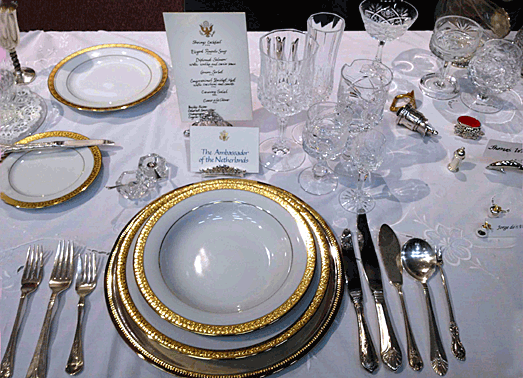
Wealthy Victorians used the best table linens on their tables. In fact,
it wasn’t uncommon for them to use two or three layers of tablecloths
which could be removed after each course.
Common centerpieces included bowls of flowers placed on beveled mirrors
or wreaths surrounding a pyramid of fruit. It was important that
centerpieces did not interfere with conversation or block guests from
being able to see one another across the table. Name cards also appeared
beside each guest’s plate.
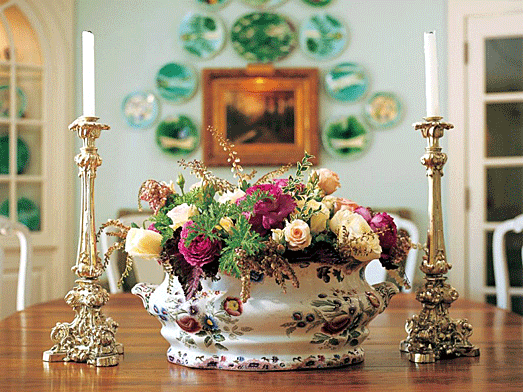
The American Agriculturalist in 1869 suggested a standard placement of
dishes for every dinner. The meat and carving utensils should be set in
front of the man, the soup in front of the lady, and the vegetables
closest to the older members of the family. A spoon should accompany
each dish served, with one or two spares available. If only two salts
were used then individual salt spoons were necessary. The salt spoons
were dispensed with if individual salts were provided at each place
setting. Dessert was to be arranged on a side table if no servants were
available. To prevent confusion, The American Agriculturalist wisely
advised, this arrangement of dishes for dinner and dessert should never
be altered.
Victorian Dinner Services
During the first half of the 19th century, a wealthy Victorian household
would have purchased separately three different dining
services—breakfast, dinner, and tea. But by the 1890s, most purchased
one set that could be used for all three types of meals. One of these
“en suite” services could conceivably consist of over 400 pieces.
Exactly what types of dishes were included in such a set was complicated
at best.

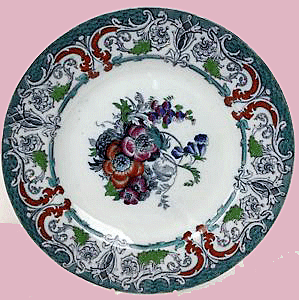 The
central piece in a dining service was the plate, which came in three
sizes—8, 9, and 10 inches. There would have been 12 of each size. Some
services included 24 of the larger plates to allow for breakage since
patterns would have been specially ordered. In descending order by size,
the plates were used for dinner, supper, and dessert.
The
central piece in a dining service was the plate, which came in three
sizes—8, 9, and 10 inches. There would have been 12 of each size. Some
services included 24 of the larger plates to allow for breakage since
patterns would have been specially ordered. In descending order by size,
the plates were used for dinner, supper, and dessert.
Also included was a nested set of oval platters which were used to serve
meat. Sizes ranged from 22 to 10 inches and went down in size by
increments of 2 inches. The 10-inch size was sometimes called a bacon
platter. A drainer was frequently included to fit one or more of these
platters. Long, narrow platters were used for serving fish. Chop plates,
measuring 11 inches or more in diameter, and fish platters were included
in some services. Occasionally, dinner services included a large
well-and-tree platter.
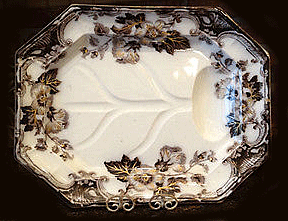 Sometimes
called a poultry dish, this distinctive platter had a gravy well molded
at one end and channels molded throughout the surface of the platter to
drain the gravy into the well. The platter's name describes the overall
appearance of the channels and the veil. An extra high rim was applied
underneath the end opposite the well to create a slope down which the
gravy would train. Many different designs were used for the patterns of
the gravy channels.
Sometimes
called a poultry dish, this distinctive platter had a gravy well molded
at one end and channels molded throughout the surface of the platter to
drain the gravy into the well. The platter's name describes the overall
appearance of the channels and the veil. An extra high rim was applied
underneath the end opposite the well to create a slope down which the
gravy would train. Many different designs were used for the patterns of
the gravy channels.
Flat, lozenge-shaped inserts pierced usually with a large central hole
and always with a pattern of small drain soles. This ceramic slab was
made in two sizes in a service to fit into 16- and 18-inch platters.
They were used to serve boiled fish, draining the excess water into the
Matter beneath the drainer. They were also used for serving meat. At
times the drain-hole patterns are distinctive.
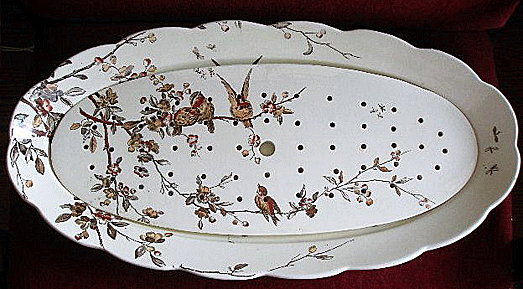
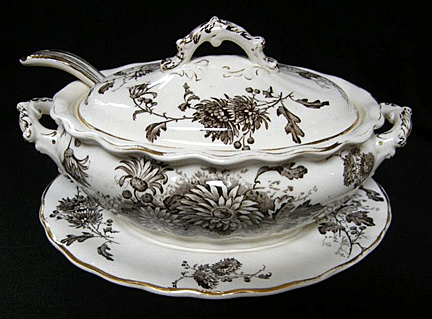 A
complete service would include one or two large soup tureens and as many
as four or six small sauce tureens. Each came with its own matching
under tray or liner, lid and ladle. The lid had small notches to fit
around the ladle handle. Low soup tureens are called chowder tureens at
times.
A
complete service would include one or two large soup tureens and as many
as four or six small sauce tureens. Each came with its own matching
under tray or liner, lid and ladle. The lid had small notches to fit
around the ladle handle. Low soup tureens are called chowder tureens at
times.
Each dinner service had one or two gravy boats with separate undertrays.
Some have the undertrays attached to the boat. You may run across a boat
with two spouts and two side-handles designed to serve sauces for fish.
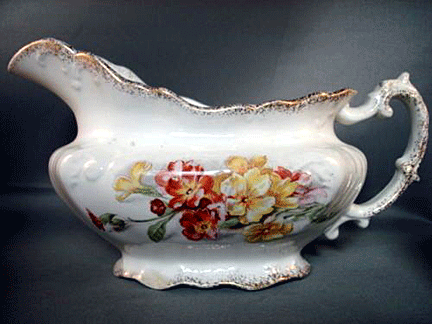 A
deep dish, covered or open, was used for serving vegetables. A dinner
service would have four, at times including an inner liner or water pan.
Open vegetable bowls came in pairs or in three graduated sizes. In
Victorian England, especially on large country estates, covered dishes
were necessary to keep food warm on its trip to the table. The lords and
ladies despised kitchen smells and kept their kitchens as far away from
the dining room as possible.
A
deep dish, covered or open, was used for serving vegetables. A dinner
service would have four, at times including an inner liner or water pan.
Open vegetable bowls came in pairs or in three graduated sizes. In
Victorian England, especially on large country estates, covered dishes
were necessary to keep food warm on its trip to the table. The lords and
ladies despised kitchen smells and kept their kitchens as far away from
the dining room as possible.
Sauce dishes served stewed fruit, applesauce and similar foods. Twelve
would be included in a service. They measured between 5 and 5 1/2 inches
and were sometimes called "nappies."
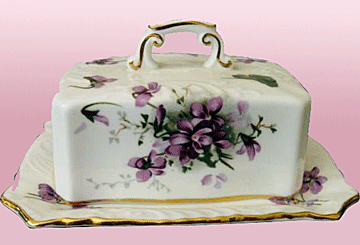 In
Flow Blue these are usually small circular dishes with covers. Some have
a pierced strainer on which the butter rests, allowing water to drain
from freshly churned butter. This strainer was also useful if chipped
ice or ice water was used to cool the butter, a necessity if but-ter was
to be served during the hot summer months in the 19'h century. Butter
dishes also came in rectangular and hexagonal shapes.
In
Flow Blue these are usually small circular dishes with covers. Some have
a pierced strainer on which the butter rests, allowing water to drain
from freshly churned butter. This strainer was also useful if chipped
ice or ice water was used to cool the butter, a necessity if but-ter was
to be served during the hot summer months in the 19'h century. Butter
dishes also came in rectangular and hexagonal shapes.
The name explains the use but it covers a wide variety of shapes. It is
most often associated with a small leaf shaped dish with dentil edges.
They were produced by many large pottery works including Ridgway and
Wedgwood but are often found unmarked. These have also been called
relish and celery dishes. Two or more of these small dishes were found
in a service.
 Custard
cups (a.k.a. punch or toddy cups) came in a dozen, with or without
matching covers. These were small capacity, single handled, often footed
cups used to serve egg custard in the last course before dessert. They
may have been used for hot punches or toddies as well.
Custard
cups (a.k.a. punch or toddy cups) came in a dozen, with or without
matching covers. These were small capacity, single handled, often footed
cups used to serve egg custard in the last course before dessert. They
may have been used for hot punches or toddies as well.
At first, tea was served in small handleless tea bowls, imitating the
Chinese custom. Cups with handles didn’t appear until the 1820s.;The
early saucers were deep, bowl shapes since the Chinese also poured their
tea into the saucer and sipped it from there. These larger saucers
measured roughly 6 inches in diameter.
During the first half of the 19th century in America, people placed
their empty cup on a special cup plate once they had poured their tea
into the large saucer to protect the table linens. Some sets included
“waste” bowls in which the dregs from cups of tea could be poured to
refresh the cup.
While cream pitchers were relatively small, sugar bowls, on the other
hand, were overly large and always came with a lid. They had large,
wide-mouthed openings to accommodate sugar processed in conical molds.
These molds created large, cone-shaped "sugar loafs" weighing five
pounds. Sugar nippers were used to snip off small pieces of the loaf,
which were placed in the large-mouthed sugar bowls. Sugar tongs lifted
these smaller lumps from the bowl to the cup. After the mid-1860s, the
process of granulating sugar crystals was developed.
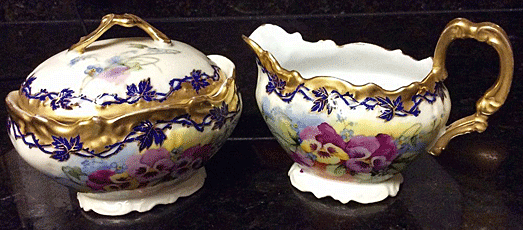
 Some
dinner services came with cake plates which could also be alternatively
used as bread and butter plates. Measuring 8 to 9 inches, they were
often square-shaped.
Some
dinner services came with cake plates which could also be alternatively
used as bread and butter plates. Measuring 8 to 9 inches, they were
often square-shaped.
When the main courses had all been served and eaten, the butler and the
footmen would remove the tablecloth and serve dessert and champagne. Up
to the end of the 19th century, Victorians could purchase a dessert
service separately from dinner services. These included a dozen 8- to
9-inch plates, tazzas or cake stands, nut or sweet dishes, ice pails and
bowls.
At the end of the dinner, women would retire to the drawing room for
coffee or tea while the men remained behind in the dining room to smoke
and drink port wine.
< Back to Collecting Archives
Next
Article >
